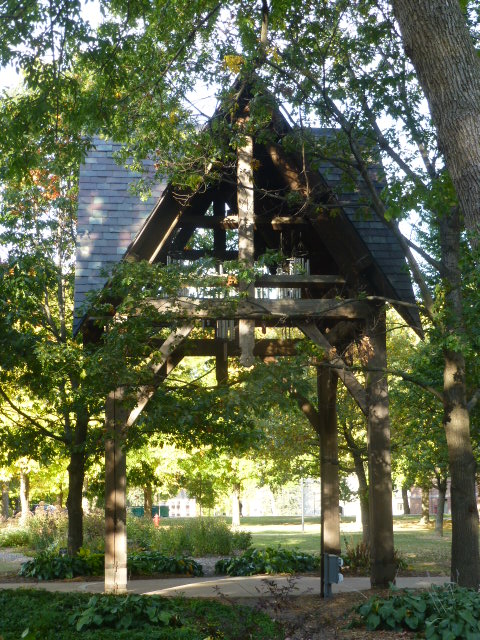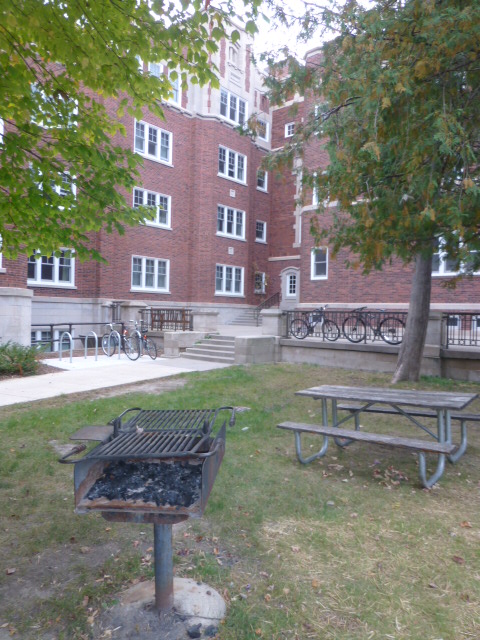St. Olaf College
St. Olaf College (visited 11/3/22)
Fun fact: This is one of few colleges in the country where students can major in Norwegian – and offers the largest number of Norwegian language courses in the country. Started as a school for Norwegian immigrants (which helps to explain the ‘um yah yah!’ chant), St. Olaf also offers a Nordic Studies major. Members of Norwegian royalty have visited campus a number of times, and the Queen was there in October 2022 for a ribbon cutting and broadcasted her weekly webcast from here.
As with all other colleges I’ve visited on the Colleges that Change Lives list, this place is phenomenal! Our tour guide said that it has definitely changed her life: “It’s the first time that I’ve been able to concentrate on being a student and build relationships. We’re in a type of bubble, but in the absolute best sort of way! I can’t thank this place enough for everything I’ve gotten here.”
“We’re kind of a quirky place. We work hard but don’t take ourselves too seriously. We like to have fun!” said our tour guide. “We don’t have Greek life, so the arts, the athletic teams, and the clubs are places we find our people.” Joining things is very much a part of the campus culture, “but it’s not pressured. People do it because they want to.” One of the reps described St. Olaf as “a traditional liberal arts college. Students who flourish here have a sense of purpose and take joy in learning with other people. People eat together. They’re social. It’s key to who we are.” This vibe shown through: students walking around were engaging with each other.
With 3000 undergrads, one person described St. Olaf as “a big small college which is how we like it. We have more diversity in identities; we have a few more people who are like – and unlike – you.” Almost ¼ of domestic students self-identify as BiPOC. Several people described the college as a highly affirming LGBTQI+ community. They have a robust First Gen support system, including mentors, affinity groups, and workshops about financial and other topics relevant to the students (including on recent one on loan forgiveness). Just over half of the students come from outside of Minnesota, including about 100 countries. They’re almost entirely residential with 95% of students living on campus all 4 years. They intentionally match roommates so that students from Minnesota live with students coming from outside of the state. As a side note, this is also a dry campus.
Campus is gorgeous with many buildings made of the same stone; it’s reminiscent of Bryn Mawr (or vice versa!). Architectural Digest ranked St. Olaf’s campus 3rd Most Beautiful Campus in the country. One reason is that there’s no traffic/parking on central campus; “Parking is available but not always the most accessible,” said one tour guide. “It’s on the outskirts to make the campus more walkable.” A few other interesting things to note: there’s a tradition to sled down the hill behind Old Main during the first snowfall every year. Holland Hall (where the social sciences are housed) was modeled off a monastery in France; the tour guide didn’t think there was a particular reason other than the architect liked it. They host a Harry Potter night in the building every fall, complete with Butter Beer, movie showings, and more. “People get entirely decked out for it!” In the center of campus sits the Memorial Chime Tower, built in 2003, which already has “lots of traditions associated with it. People will come back and get engaged here.”
Campus sits on a hill overlooking the town Northfield and is surrounded by 400 campus-owned acres of land that includes several miles of trails used by students and faculty. (There’s also an oatmeal factory nearby, and the tour guide loves it: “It smells so good!”) Downtown is a short walk away. Carleton is the other university in town; students can take classes there, provided the same class isn’t being offered at St. Olaf. We asked students about this; “it’s done but it’s not super common.” There’s a busing system that students can use around town that also runs up to the Twin Cities, including to the Mall of America and the airport (about 40 minutes north).
Students agree that academics are challenging – but motivated students will do just fine. There’s a lot of resources and support to help the transition but “it’s on you to take advantage of what they offer.” Students major in everything from Dance to Quantitative Economics to Classics (they still teach Latin and Greek). “We’re a little more expansive than some liberal arts colleges, including nursing and social work.” Music is also a big deal; 30% of students participate in some way. They operate a bit like a conservatory (think Lawrence or Oberlin) but it’s integrated more seamlessly into the liberal arts. I loved that a student was in an alcove outside the music building practicing his trombone as we walked by – and didn’t care who was listening! Approximately 700 students participate in the yearly Christmas Festival concert. This year, it’s held at Orchestra Hall in Minneapolis “which is disappointing to alumni and others who wanted to come to campus for their Lutheran Buffet,” said the tour guide.
I asked a couple students what their favorite/coolest class was:
- Film and Media Theory – “He treated us like we’re capable of rising to the challenge of the dense material. We looked at some tricky stuff, but it was dynamic and relevant; he brought it to life.”
- Urban Sociology – “We live in a city. We researched an urban city in what we call home and did ethnographic research. It was eye-opening.”
They’re on a 4-1-4 academic calendar. Interim, a month in January, “focuses on one thing. It’s a great personal and intellectual experience,” said the tour guide. “It’s also a great time to be on campus. It’s cold as hell, but it’s contemplative.” However, in any given Interim, 600 students study off campus; many students do more than one trip as an undergrad. There are also plenty of summer opportunities on and off campus. Many students stick around for research or to work on the campus farm that supplies food to the dining hall. They’re big on Farm to Fork and other sustainable efforts – there’s even a wind turbine on campus (not so subtly called “Big Ole”) which provides about 1/3 of power on campus.
Another thing St. Olaf is known for is providing opportunities to study off campus. They’ve been named a top institution for numbers of students who study abroad. There are robust opportunities for semester or year-long study abroad in addition to Interim. Students are globally engaged. “People show up asking where they’re going to study abroad. It’s part of the culture here.” They offer extensive language classes (and majors), concentrations, Learning Communities, and other opportunities that support language acquisition, cultural appreciation, and more. Students can get a certificate in Languages Across the Curriculum or join learning communities such as Asian Conversations.
St. Olaf is one of 26 US institutions affiliated with the Evangelical Lutheran Church in America, one of the largest Christian denominations in the US with about 3 million members. However, this is classified as a “Third-Path Institution”: it’s both religiously rooted and religiously inclusive. “It falls between Sectarian (deeply rooted in one religious tradition and dedicated to nurturing students in that tradition, going out of their way to have students and staff of that one denomination) and Non-Sectarian with no religious rootedness.” Only 20% of their student body self-identify as Lutheran as compared to 26% who don’t claim an affiliation. They could do a better job of attracting students from non-Christian faiths: only about 6% of students self-identify as members of another religion (Hindu, Jain, Muslim, and Jewish). Despite this, they do have a rabbi on staff and have some active student groups, including one for Muslim students.
This is a place that students can come and have conversations about faith – but it’s not expected. They can also be a person of NO faith. “Lutheran tradition invites people to engage with a body of thought,” said a rep. Students must fulfill religious 2 Gen Ed requirements:
- Religion, Faith, and Values which builds religious literacy with a focus on a religious tradition or set of related traditions.
- Christian Theology in Dialogue which focuses on the dialogue of ideas: there’s a list of options including things like Queer Theory in Christianity or Religious Pluralism and Community.
One of the professors said that “learning about religions is the unlearning of hate. It comes down to having conversations with other people who may be different from you. St Olaf does a good job of that.” A daily Chapel service is offered but never required. The chapel itself is an event space so students say that if feels inclusive. “Religion is as large or as small as you want it to be,” said a student which is a common refrain at many schools I’ve visited.
In one of our discussions with Admissions, Deans, and Faculty, we asked, “Who is going to choose St. Olaf over the others?” referring to Carleton and Macalester, the 2 peer institutions we also visited on this fly-in. The answers were interesting:
- “The community is built differently here – not better, just different. There’s an ethos here based on trust and honor. We have an Honor Code that’s taken very seriously. Professors don’t proctor exams. The students’ mailboxes aren’t locked. There’s a lot of trust on campus.”
- “We attract different students. Students who come here are asking, ‘What do I need to know to be a better music teacher when I get out?’ not ‘What do I need to do to get an A?’ We don’t get a lot of cross-apps. I think all the colleges benefit when students visit St. Olaf and Carleton [both in the same town] at the same time and when they visit Mac, too. Sometimes being bigger helps. St Olaf tends to hits all the boxes.”
© 2022






























